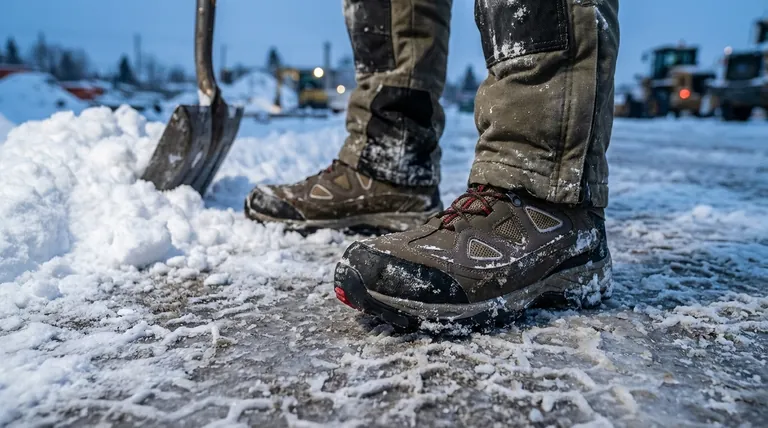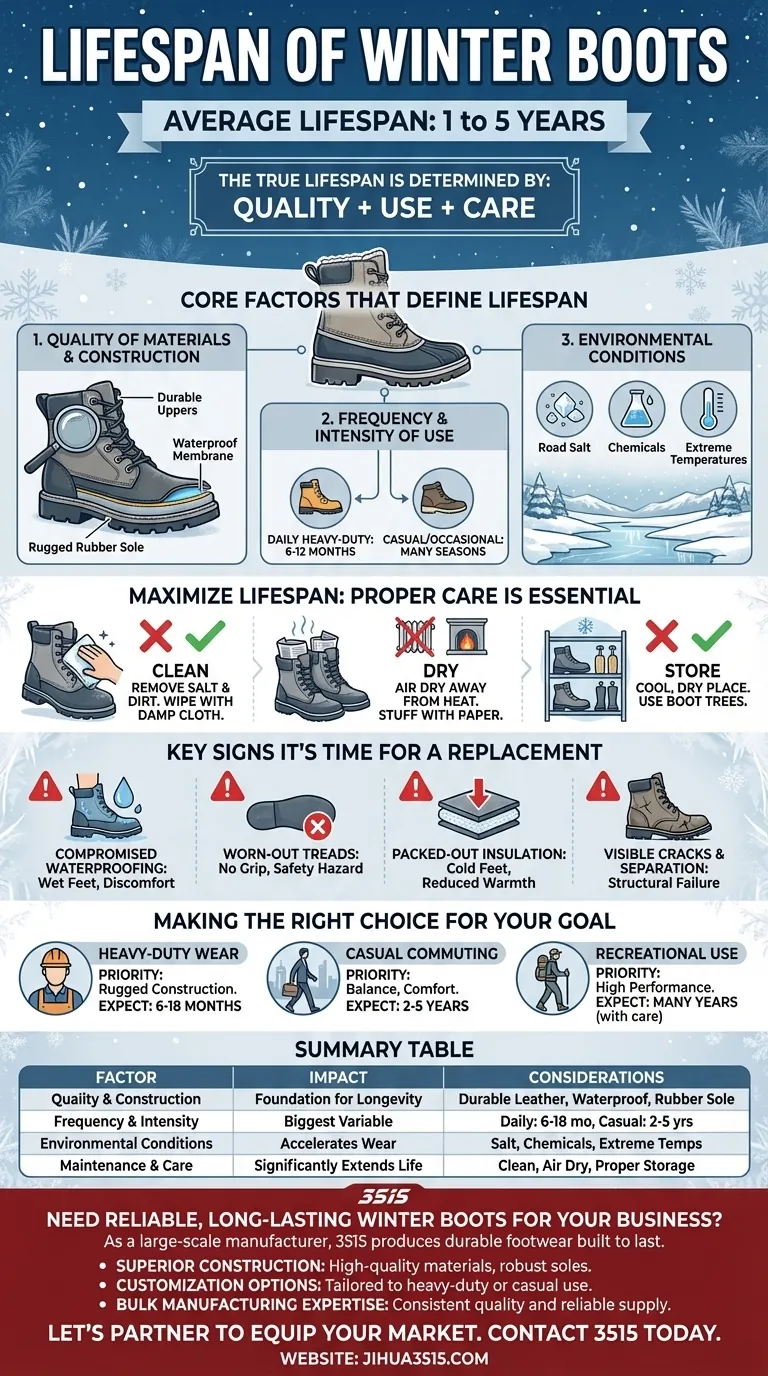On average, you can expect a quality pair of winter boots to last anywhere from one to five years. This lifespan, however, is not a fixed guarantee. It is highly dependent on the boot's initial quality, the frequency and intensity of its use, and the consistency of its maintenance.
The true lifespan of your winter boots isn't determined by a calendar, but by a combination of three key factors: the quality of their construction, the harshness of their environment, and the diligence of their care.

The Core Factors That Define a Boot's Lifespan
Understanding what makes a boot durable is the first step in estimating its longevity. A boot's lifespan is set in motion the moment it's manufactured.
Quality of Materials and Construction
A boot built with superior materials will fundamentally last longer. Look for thick, durable uppers, often made of treated leather, which provides excellent support and stability.
A critical feature is a waterproof membrane, such as Gore-Tex, which keeps feet dry and protects the boot's internal structure from moisture damage.
The sole is the boot's point of contact with the world. A high-quality rubber sole with deep, aggressive treads not only provides essential traction on snow and ice but also resists wear and tear far better than softer compounds.
Frequency and Intensity of Use
How you use your boots is the single biggest variable. Boots worn daily for demanding work, like construction, may need replacement in as little as six to twelve months.
In contrast, boots used for casual city commuting or occasional weekend activities can last for many seasons. Heavy-duty use like winter hiking or snowshoeing will accelerate wear on the soles and seams.
Environmental Conditions
The environment your boots face matters. Constant exposure to road salt, de-icing chemicals, and extreme temperature fluctuations will degrade leather, rubber, and stitching over time.
Boots used in milder winter climates will naturally outlast those subjected to harsh, wet, and icy conditions day after day.
How to Maximize the Lifespan of Your Boots
Proper care is not optional; it is essential for getting the most out of your investment. A few simple habits can easily add years to a boot's life.
The Importance of Proper Cleaning
Always clean dirt, mud, and especially salt off your boots after use. Salt can dry out and permanently damage leather, causing it to crack. A simple wipe-down with a damp cloth is often sufficient.
The Critical Role of Drying
Never dry wet boots near a direct heat source like a radiator or fireplace. Intense heat can cause leather to shrink and crack, and it can weaken the adhesives that bond the sole to the upper.
Instead, let them air dry at room temperature. You can stuff them with newspaper to absorb excess moisture and help them maintain their shape.
Smart Storage Practices
During the off-season, store your boots in a cool, dry place away from direct sunlight. Sunlight can fade colors and degrade materials over time. Using boot trees or stuffing them with paper helps prevent creases and cracks from forming.
Key Signs It's Time for a Replacement
Even the best-cared-for boots have a finite life. Ignoring the signs of failure is not just a matter of comfort; it's a matter of safety.
Compromised Waterproofing
If your feet are getting wet, the boot's primary function has failed. Water intrusion can lead to cold, discomfort, and health risks, and it signals a breakdown in the boot's materials or seams.
Worn-Out Treads
Turn your boots over and inspect the sole. If the treads are worn smooth, the boot has lost its ability to grip on ice and snow. This is a significant safety hazard that should not be ignored.
Packed-Out Insulation
Over time, the insulation inside a boot can compress, creating empty space. This "packed-out" effect dramatically reduces its ability to keep your feet warm, defeating a core purpose of a winter boot.
Visible Cracks and Separation
Inspect the boot for deep cracks in the leather or rubber, especially where the foot flexes. Pay close attention to the area where the sole meets the upper. Any sign of separation means the boot's structural integrity is compromised.
Making the Right Choice for Your Goal
Select and maintain your boots based on your primary needs to ensure you get the performance and longevity you expect.
- If your primary focus is daily, heavy-duty wear: Prioritize rugged construction and durable materials, and realistically expect to replace them every 6-18 months.
- If your primary focus is frequent casual commuting: Look for a balance of waterproofing, comfort, and style, and expect a 2-5 year lifespan with proper care.
- If your primary focus is occasional recreational use: Invest in high-performance features like excellent traction and insulation; these boots can last for many years if cleaned and stored correctly after each use.
Ultimately, viewing your winter boots as essential equipment that requires routine maintenance is the key to maximizing their value and performance.
Summary Table:
| Factor | Impact on Lifespan | Key Considerations |
|---|---|---|
| Quality & Construction | Sets the foundation for longevity. | Durable leather, waterproof membrane, rugged rubber sole. |
| Frequency & Intensity of Use | The biggest variable. | Daily heavy-duty use: 6-18 months. Casual use: 2-5 years. |
| Environmental Conditions | Accelerates wear. | Exposure to salt, chemicals, and extreme temperatures. |
| Maintenance & Care | Can significantly extend life. | Proper cleaning, air drying, and correct off-season storage. |
Need Reliable, Long-Lasting Winter Boots for Your Business?
As a large-scale manufacturer, 3515 produces a comprehensive range of durable footwear built to last. We understand that lifespan is critical for your customers' satisfaction and your brand's reputation.
We provide:
- Superior Construction: Boots crafted with high-quality materials like treated leather and robust rubber soles.
- Customization Options: Tailor boots to specific use cases—from heavy-duty work to casual commuting.
- Bulk Manufacturing Expertise: Consistent quality and reliable supply for distributors, brand owners, and bulk clients.
Let's partner to equip your market with footwear that delivers on its promise of durability and performance.
Contact 3515 today to discuss your production needs and get a quote.
Visual Guide

Related Products
- Safety Footwear Wholesale Manufacturer for Custom OEM/ODM Production
- Wholesale Safety Footwear Manufacturer for Bulk & Custom OEM Orders
- Premium Wholesale Waterproof Safety Boots High Performance Protection for Industrial Markets
- High Performance Fire-Retardant Waterproof Safety Boots
- Premium Flame-Retardant Waterproof Safety Boots and Shoes
People Also Ask
- How do safety shoes contribute to cost savings for companies? A Strategic Investment in Risk and Cost Management
- Do snake bite boots work? Your Ultimate Guide to Effective Snake Bite Protection
- What are the differences between steel toe, composite toe, and alloy toe Wellington boots? Choose the Right Safety Toe for Your Job
- What do heavy duty boots do? Protect Your Feet in Demanding Work Environments
- Is it normal to wear shoes in the house? A Guide to Hygiene, Comfort & Culture



















